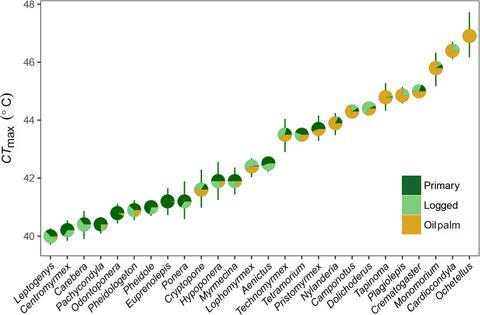当前位置:
X-MOL 学术
›
Funct. Ecol.
›
论文详情
Our official English website, www.x-mol.net, welcomes your
feedback! (Note: you will need to create a separate account there.)
Localised climate change defines ant communities in human‐modified tropical landscapes
Functional Ecology ( IF 4.6 ) Pub Date : 2020-12-07 , DOI: 10.1111/1365-2435.13737 Michael J. W. Boyle 1, 2, 3 , Tom R. Bishop 4, 5 , Sarah H. Luke 6, 7 , Michiel Breugel 8, 9 , Theodore A. Evans 2, 10 , Marion Pfeifer 1, 11 , Tom M. Fayle 1, 12, 13 , Stephen R. Hardwick 1 , Rachel Isolde Lane‐Shaw 1 , Kalsum M. Yusah 13 , Imogen C. R. Ashford 7 , Oliver S. Ashford 7, 14 , Emma Garnett 7 , Edgar C. Turner 1, 7 , Clare L. Wilkinson 1, 2 , Arthur Y. C. Chung 15 , Robert M. Ewers 1
中文翻译:

局部气候变化在人工改造的热带景观中定义了蚂蚁群落
更新日期:2020-12-07
Functional Ecology ( IF 4.6 ) Pub Date : 2020-12-07 , DOI: 10.1111/1365-2435.13737 Michael J. W. Boyle 1, 2, 3 , Tom R. Bishop 4, 5 , Sarah H. Luke 6, 7 , Michiel Breugel 8, 9 , Theodore A. Evans 2, 10 , Marion Pfeifer 1, 11 , Tom M. Fayle 1, 12, 13 , Stephen R. Hardwick 1 , Rachel Isolde Lane‐Shaw 1 , Kalsum M. Yusah 13 , Imogen C. R. Ashford 7 , Oliver S. Ashford 7, 14 , Emma Garnett 7 , Edgar C. Turner 1, 7 , Clare L. Wilkinson 1, 2 , Arthur Y. C. Chung 15 , Robert M. Ewers 1
Affiliation

|
- Logging and habitat conversion create hotter microclimates in tropical forest landscapes, representing a powerful form of localised anthropogenic climate change. It is widely believed that these emergent conditions are responsible for driving changes in communities of organisms found in modified tropical forests, although the empirical evidence base for this is lacking.
- Here we investigated how interactions between the physiological traits of genera and the environmental temperatures they experience lead to functional and compositional changes in communities of ants, a key organism in tropical forest ecosystems.
- We found that the abundance and activity of ant genera along a gradient of forest disturbance in Sabah, Malaysian Borneo, was defined by an interaction between their thermal tolerance (CTmax) and environmental temperature. In more disturbed, warmer habitats, genera with high CTmax had increased relative abundance and functional activity, and those with low CTmax had decreased relative abundance and functional activity.
- This interaction determined abundance changes between primary and logged forest that differed in daily maximum temperature by a modest 1.1°C, and strengthened as the change in microclimate increased with disturbance. Between habitats that differed by 5.6°C (primary forest to oil palm) and 4.5°C (logged forest to oil palm), a 1°C difference in CTmax among genera led to a 23% and 16% change in relative abundance, and a 22% and 17% difference in functional activity. CTmax was negatively correlated with body size and trophic position, with ants becoming significantly smaller and less predatory as microclimate temperatures increased.
- Our results provide evidence to support the widely held, but never directly tested, assumption that physiological tolerances underpin the influence of disturbance‐induced microclimate change on the abundance and function of invertebrates in tropical landscapes.
中文翻译:

局部气候变化在人工改造的热带景观中定义了蚂蚁群落
- 伐木和栖息地转换在热带森林景观中创造了更热的小气候,这代表了局部人为气候变化的有力形式。人们普遍认为,尽管缺乏经验证据,但这些紧急情况是造成热带热带森林中生物群落发生变化的原因。
- 在这里,我们调查了属的生理特征与其所经历的环境温度之间的相互作用如何导致蚂蚁群落(热带森林生态系统中的关键生物)的功能和成分变化。
- 我们发现,蚂蚁属的丰富度和活动沿着马来西亚婆罗洲的沙巴州森林扰动的梯度是由它们的热耐受性(CT max)和环境温度之间的相互作用所定义的。在更受干扰的温暖生境中,CT max较高的属具有相对丰度和功能活性,而CT max较低的属具有相对丰度和功能活性降低。
- 这种相互作用决定了原始森林和伐木森林之间的丰度变化,这些变化的每日最高温度相差仅1.1°C,并且随着微气候变化随干扰的增加而增强。在相差5.6°C(从原始森林到油棕)和4.5°C(从原木到油棕榈)的栖息地之间,属间最大CT值相差1°C,导致相对丰度发生了23%和16%的变化,以及功能活动的差异分别为22%和17%。CT max与体型和营养位置呈负相关,随着微气候温度的升高,蚂蚁的体型显着变小,掠食性降低。
- 我们的结果提供了证据,以支持广泛接受但从未直接测试过的假设,即生理上的耐受性是干扰引起的小气候变化对热带景观中无脊椎动物数量和功能的影响的基础。










































 京公网安备 11010802027423号
京公网安备 11010802027423号